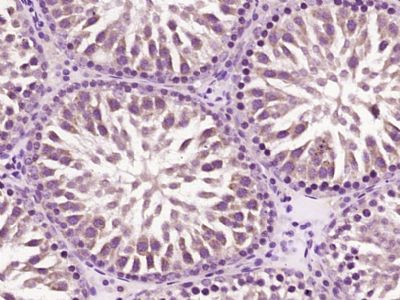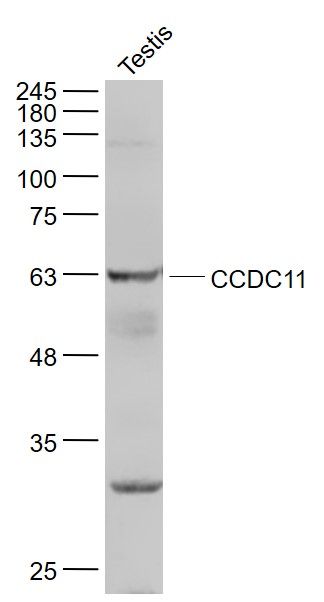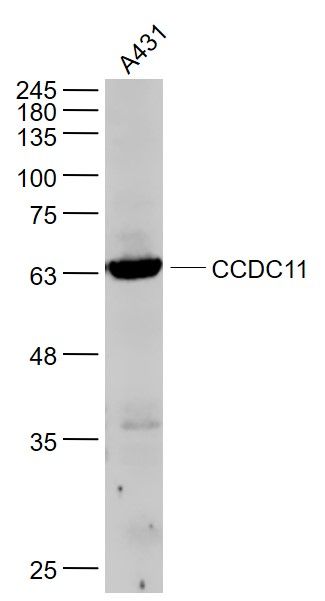CCDC11 Polyclonal Antibody
Purified Rabbit Polyclonal Antibody (Pab)
- SPECIFICATION
- CITATIONS
- PROTOCOLS
- BACKGROUND

Application
| WB, IHC-P, IHC-F, IF, E |
|---|---|
| Primary Accession | Q96M91 |
| Reactivity | Rat, Bovine |
| Host | Rabbit |
| Clonality | Polyclonal |
| Calculated MW | 61835 Da |
| Gene ID | 220136 |
|---|---|
| Other Names | Cilia- and flagella-associated protein 53 {ECO:0000312|HGNC:HGNC:26530}, Coiled-coil domain-containing protein 11 {ECO:0000312|HGNC:HGNC:26530}, CFAP53 (HGNC:26530) |
| Dilution | WB=1:500-2000,IHC-P=1:100-500,IHC-F=1:100-500,IF=1:100-500,ELISA=1:5000-10000 |
| Format | 0.01M TBS(pH7.4), 0.09% (W/V) sodium azide and 50% Glyce |
| Storage | Store at -20 ℃ for one year. Avoid repeated freeze/thaw cycles. When reconstituted in sterile pH 7.4 0.01M PBS or diluent of antibody the antibody is stable for at least two weeks at 2-4 ℃. |
| Name | CFAP53 (HGNC:26530) |
|---|---|
| Function | Microtubule inner protein (MIP) part of the dynein-decorated doublet microtubules (DMTs) in cilia axoneme, which is required for motile cilia beating (PubMed:36191189). Regulates motility patterns of both 9+0 and 9+2 motile cilia through differential localization and recruitment of axonemal dynein components (By similarity). Required for centriolar satellite integrity and non-motile cilium assembly (PubMed:26538025). Required for motile cilium formation (PubMed:26538025). Through its role in the beating of primary cilia, involved in the establishment of organ laterality during embryogenesis (PubMed:26531781). Required for sperm flagellum biogenesis and is essential for male fertility (By similarity). |
| Cellular Location | Cytoplasm, cytoskeleton, cilium axoneme. Cytoplasm, cytoskeleton, flagellum axoneme {ECO:0000250|UniProtKB:Q9D439} Cytoplasm, cytoskeleton, microtubule organizing center, centrosome, centriole. Cytoplasm, cytoskeleton, microtubule organizing center, centrosome, centriolar satellite. Cytoplasm, cytoskeleton, spindle pole. Cytoplasm, cytoskeleton. Cell projection, cilium. Note=In tracheal cell cilia, localizes prominently to both centriolar satellites and axonemes (By similarity) Tightly associated with microtubules in tracheal cilia (By similarity) In embryonic node cells, localizes to the base of the node cilia at the centriolar satellites and, to a lesser extent, to the cilium axoneme (By similarity). Localizes to centriolar satellites through G1, S phase, G2 and mitosis (PubMed:26538025). Enriched on the spindle poles in mitosis (PubMed:26538025). Relocalizes from the centriolar satellite to the ciliary transition zone upon ciliogenesis (PubMed:26538025). In skin fibroblast cells, locates predominantly to the centriole with much lower levels associated with the actin cytoskeleton (PubMed:28621423) Localizes to the sperm flagellum and manchette (By similarity) {ECO:0000250|UniProtKB:Q9D439, ECO:0000269|PubMed:26538025, ECO:0000269|PubMed:28621423} |
| Tissue Location | Expressed in skin fibroblasts (at protein level) (PubMed:22577226, PubMed:28621423). Expressed in nasal respiratory epithelial cells (at protein level) (PubMed:25504577). Expressed in airway epithelial cells (PubMed:36191189) |

Thousands of laboratories across the world have published research that depended on the performance of antibodies from Abcepta to advance their research. Check out links to articles that cite our products in major peer-reviewed journals, organized by research category.
info@abcepta.com, and receive a free "I Love Antibodies" mug.
Provided below are standard protocols that you may find useful for product applications.
If you have used an Abcepta product and would like to share how it has performed, please click on the "Submit Review" button and provide the requested information. Our staff will examine and post your review and contact you if needed.
If you have any additional inquiries please email technical services at tech@abcepta.com.













 Foundational characteristics of cancer include proliferation, angiogenesis, migration, evasion of apoptosis, and cellular immortality. Find key markers for these cellular processes and antibodies to detect them.
Foundational characteristics of cancer include proliferation, angiogenesis, migration, evasion of apoptosis, and cellular immortality. Find key markers for these cellular processes and antibodies to detect them. The SUMOplot™ Analysis Program predicts and scores sumoylation sites in your protein. SUMOylation is a post-translational modification involved in various cellular processes, such as nuclear-cytosolic transport, transcriptional regulation, apoptosis, protein stability, response to stress, and progression through the cell cycle.
The SUMOplot™ Analysis Program predicts and scores sumoylation sites in your protein. SUMOylation is a post-translational modification involved in various cellular processes, such as nuclear-cytosolic transport, transcriptional regulation, apoptosis, protein stability, response to stress, and progression through the cell cycle. The Autophagy Receptor Motif Plotter predicts and scores autophagy receptor binding sites in your protein. Identifying proteins connected to this pathway is critical to understanding the role of autophagy in physiological as well as pathological processes such as development, differentiation, neurodegenerative diseases, stress, infection, and cancer.
The Autophagy Receptor Motif Plotter predicts and scores autophagy receptor binding sites in your protein. Identifying proteins connected to this pathway is critical to understanding the role of autophagy in physiological as well as pathological processes such as development, differentiation, neurodegenerative diseases, stress, infection, and cancer.




